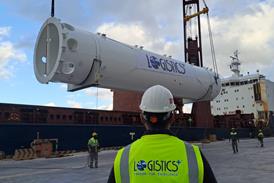March 9 - Sarens has used its Terex Superlift 3800 lattice boom crawler crane to lift a steel footbridge over the A4 autoroute near Schiltigheim in the French region of Alsace.
Sarens project manager Joost Elsen explained that the company had to first figure out how to transport the massive crane to the jobsite, since it did not have special permissions to move such a heavy load on the road.
By using the Terex crane's 'Quick Connection' - which allows for the crane's basic structure to be disassembled into two parts in order to reduce the transport weights - the Sarens team could deliver the crawler crane to the site using a total of 56 vehicles.
But the road transport was not simple either, explained Terex. Since the access road to the site was very narrow, the trucks had to reverse along a gravel road for about 1 km to reach the installation site.
Once all components were delivered and the crane was assembled, a trial lift was carried out in order to test the crane, as well as the machine's load-securing devices.
Having successfully completed the test lift, the Superlift 3800 was set up with an SSL1 configuration, a 54 m main boom and 325 tonnes of Superlift counterweight, ready for the main event.
At night, with the road closed and a 22 m wide space to manoeuvre in, the crane picked up the 162-tonne bridge section, which measured 65 m long by 3.5 m wide, and lifted it to a height of 20 m at a working radius of 40 m.
Once in the air, the main boom was raised in order to reduce the working radius to 29 m and decrease the Superlift counterweight radius from 18 m to 11 m. This enabled the crane to turn 180 degrees within its tight working area and swing the bridge over the highway. "To do this, we used the crane's Vario Superlift system, which was developed precisely for this kind of scenario," explained crane operator Michael Bräckle.
Once the bridge was swung over the highway, the crane moved forward about 12 m under load. When the crane had reached its final destination, the main boom was brought down and the Vario system was used to bring the SL counterweight back to a radius of 18 m. Finally, the bridge section was lowered onto the bridge piers at the original working radius of about 40 m.
Watch a video of the project below:

















